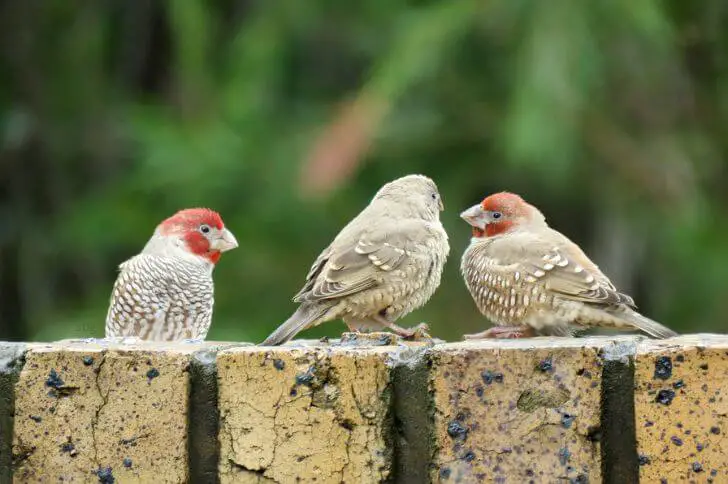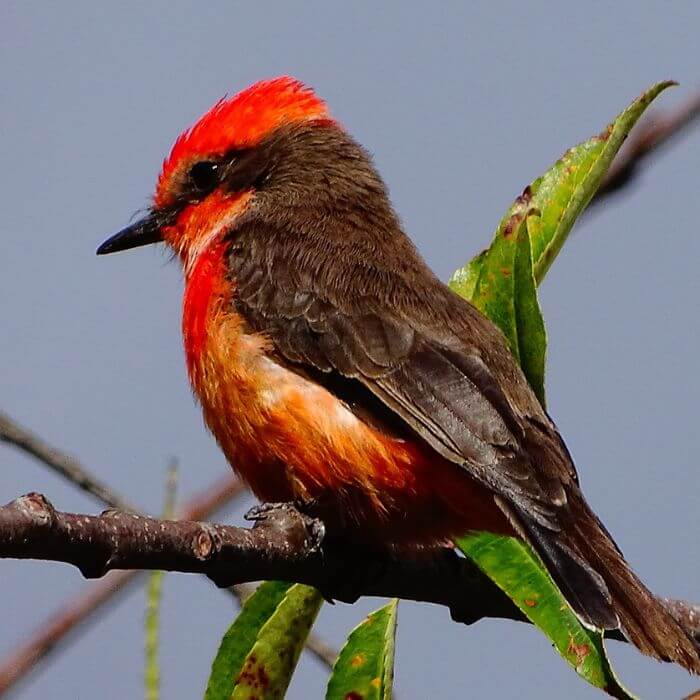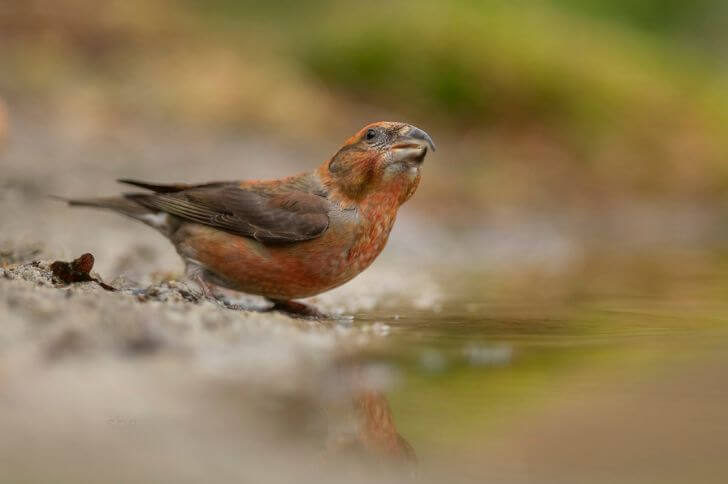Birds come in all sizes and colors and although most birds have feathers that are predominantly brown, there are some species which stand out from the rest with red heads. These brown birds with red heads can be found in many different environments around the world and have a variety of characteristics which make them unique.
From their vocalizations to their nesting habits, these birds are an interesting and diverse group that provide an exciting opportunity for birdwatchers and nature enthusiasts alike. Common finches with red heads include house finch and red-headed finch.
List of Brown Birds with Red Heads
1. Red-headed Finch (Paradise Finch)

ID:
Red-headed finches are the most common red headed sparrows. Also called the paradise finch, this small brown bird prefers living in large flocks.
It has a unique appearance that sets it apart from other finches. Male has a striking red head, brown-grayish back, white and brown underbody and a white tipped tail.
The female of this species is also brownish and gray with a gray colored head. Note the pale canonical bill.
Habitat & more:
What do red-headed finches eat? Like other finches, these birds consume a lot of seeds and peaches, figs and blackberries.
Red-headed finches are common in parts of Africa; South Africa, Angola, Zimbabwe, and Namibia. On your next safari, be on the lookout for these birds with brown bodies and red heads.
2. Cassin’s Finch

ID:
Cassin’s Finch is a unique species of bird found in the western United States and Canada. This small, but colorful finch is easily identifiable by its reddish-brown head, reddish-brown streaked back, and white belly and rump.
The female cassin’s finch is duller. She is brown overall with dark streaks on the pale underbelly. Like the paradise finch above, they have a canonical bill though smaller in size.
Habitat & more:
Cassin’s Finches prefer open woodlands in coniferous forests at elevations up to 10000 feet. They eat seeds from conifers such as pines and spruces, as well as acorns from oaks or other hardwood trees.
During winter months they may also feed on berries such as firethorn berries, mulberries and grapes for extra sustenance. These red-headed brown birds can raise 2 broods each nesting season.
3. Vermilion Flycatcher

ID:
The Southern United States is home to different species of flycatchers. The vermilion flycatcher is a small, brilliantly-colored bird that can be found in the southern United States. With its distinctive red underbody, bright red cap, and brown wings and tail, it stands out among other birds in its habitat.
Females have compact bodies with white breasts, brown heads and back, and orange-red bellies. This small reddish-brown bird is about 5.1-5.5 inches and spans about 9.8 inches. Note the white eyebrow on females and black mask on males.
Its bright coloration makes it one of the most easily identifiable species of flycatchers.
Habitat & more:
Vermilion flycatchers live for at least 4 years. Their courtship is interesting with the male offering females gifts such as butterflies. Also during their nesting, they can raise two clutches of 2-4 babies.
Related read: Check different brown birds with white heads
4. Red Crossbill

Red crossbills are sexually dimorphic. The male is reddish overall with dark brown wings. Female crossbills are yellowish overall with brownish wings. Both sexes have crisscrossed bills.
These brown birds with red heads are about 7.8 inches and boast a 11.4 inches wingspan.
Habitat & more:
What do red crossbills eat? Their bill gives them an advantage when foraging for pine and spruce seeds, as it allows them to easily extract the seeds from cones of conifer trees from which other bird species may struggle to feed.
During breeding, these brown and red birds build bulky nests out of seed-pod fibers, grasses, twigs, hair and fibers. They raise 2-6 babies. How long do crossbills live? Average life expectancy is 8 years. They are monogamous.
5. House Finch

Most homeowners hate house finches. These red headed brown birds are found all over North America and are a nuisance. Identifying them is easy.
These birds have small, stout bodies, and their wingspan is typically between 7.9-9.8 inches in length. The male house finch has a reddish head, upper body and breast coloration, with brown streaks along the sides of their neck and back.
Female house finches have brownish coloring and are much duller than males. The males are a small bird with red head.
Habitat & more:
Why are house finches disliked? They are known for their eagerness to consume food out of bird feeders, displacing other birds. For example, you may set up feeders wanting to attract cardinals or chickadees but end up with house finches.
Also, this red head bird with brown body is a prolific breeder. It can raise up to 6 clutches of 2-6 babies; meaning each season a breeding house finch pair can raise up to 36 babies. On average, this bird can live up to 10 years; that’s a lot of babies.
6. Purple Finch

ID:
Another bird of North America with brown and red plumage is the purple finch. The male is known for its raspberry red plumage on its head, brown wings and whitish belly. Female purple finches are brownish and streaked. Note the eyebrow.
These red headed finches grow to 6.3 inches in length and span 10.2 inches.
Habitat & more:
The purple finch can often be heard singing in open woodlands or near suburban areas in early spring when they are migrating from their southern winter homes back up north to their breeding grounds.
They typically sing loud and cheerful songs with a variety of chirps and whistles, making them easy to identify among other bird species by sound alone. You can watch their breeding habits from April to August.
7. Red-crested Pochard

Are there large brown birds with red heads? The red crested pochard is a species of duck found throughout much of Eurasia and it fits this list perfectly. It has a rusty-red head and a long, wide red bill.
The male of this duck species can also be identified by its brown back and wings and black chest. Female red-crested pochards are brown-gray overall with a dark bill.
Habitat & more:
These ducks prefer freshwater habitats such as lakes, ponds and slow-moving rivers. They tend to avoid fast-flowing water bodies like rapids or streams as they prefer calm waters where they can dive for food. They also need plenty of vegetation around the edges of the water bodies as this provides shelter and nesting sites.
Red-crested pochards are known to migrate during the winter months when it gets too cold in their breeding grounds.
8. Painted Finch

Known for its expansive outback, Australia is home to some of the most beautiful birds on the planet. Painted finches are gorgeous. Native to Australia, adult males have a brownish upper body, red head and black flanks with white spots. Note the red patches on the belly and rump.
Females are duller with the red plumage concentrated on their cheeks and belly. They grow to 4.7 inches in length.
Habitat & more:
These birds with brown body and red head require access to fresh water sources such as streams or ponds, as well as plenty of grasses and shrubs for nesting and feeding. These birds are primarily seed-eaters but will also consume insects during breeding season to provide protein for their young. It’s essential that their habitat provides ample food sources year-round to ensure the health of the population.
9. Red-headed Bunting

The red plumage on the red-headed bunting is more subdued compared to other red headed birds on this list. Residing in parts of Europe, Asia and the Middle East, these feathered friends are instantly recognizable for their brown backs, yellow bellies, and rusty red heads.
Like other red headed finches, the females are duller. They typically have a streaked back and a pale brown overall. Notice the slightly forked tail.
Habitat & more:
Red-headed buntings feed on insects, grains, fruit and seeds primarily found on the ground or in bushes. They can often be spotted near woodlands or along roadsides as they search for food items during their migration journeys.
10. Red-headed Quelea
Another red-headed bird of Africa that birders get to enjoy when on safari is the red-headed quelea.
With a bright red head and neck and brown body, this bird stands out from its mates. The red-headed quelea is also noted for its impressive flocking behavior, often seen in small groups Females have brown streaked backs and pale underbelly.

Habitat & more:
These birds are found in sub-Saharan Africa and are known for their ability to live in a variety of habitats. However, they usually prefer habitats with large grassy areas, such as savannas or fields.
The Red-headed Quelea is a social bird that lives in flocks. These flocks are often seen foraging together, feeding on seeds and grains from various plants. Their diet also includes insects during the breeding season when protein intake is essential for young chicks’ growth and development.
11. Red-fronted Rosefinch

With a streaky brown body, a red rump and red head, the red-fronted rosefinch male is a small colorful bird native to the Himalayan region. Their chest is also reddish.
Females are not as bright. Their chunky bodies are brown with heavy streaking. Notice their canonical bills and dark feet. Additionally, its unique call is often louder than those of other finches in the same area making it easier to locate when out in the field.
Habitat & more:
During breeding season, the Red-fronted Rosefinch builds its nest on or near the ground in shrubs or low trees. The female lays a clutch of 3-5 eggs which she incubates for around 13 days. You can spot them in open meadows, rocky slopes, and cliff edges.
FAQs
What kind of bird looks like a sparrow with red head?
Male House Finch. These birds are roughly the same size and shape as sparrows, but their distinctive red coloring sets them apart. Interestingly, female House Finches have more muted coloring – they are mostly brown with some streaks of white or gray!
What bird has a red face?
One of the most well-known birds with a red face is the Northern Cardinal. This bird is easily recognizable by its bright red plumage and distinctive crest atop its head. The male cardinal’s face is also bright red, while the female’s is more muted.
Another bird with a prominent red face is the Red-faced Cormorant. These seabirds are found along the coasts of Alaska and eastern Asia and are known for their strikingly colorful appearance. Their faces are a deep shade of crimson, making them easy to spot on rocky shorelines or in flight over open water.
What is a brown bird with a red stripe on the back of its head?
Northern flickers. They have brownish-gray bodies and a red patch on the nape of the neck.
What is a brown bird with a redhead?
Common brown birds with red heads include:
- Red-headed finch
- Vermilion flycatcher
- House finch
- Painted finch
- Purple finch
What is a yellow brown bird with a red head?
The male Red-headed Bunting has more vibrant coloring than the female, making it easier to identify. Its bright red head coloration stands out against the muted tones of its surroundings. Its upper body is brown while the underbody is yellowish. Females have less intense coloring without the red head.
sources:
https://ebird.org/species/rehfin1
https://www.allaboutbirds.org/guide/House_Finch/id
https://en.wikipedia.org/wiki/Purple_finch
Hi fellow bird watcher. Welcome to our small corner of the world. At the spanishbirdguides.com our mission is to share with other bird watchers the things we love about birds, where to go bird watching within the United States, and more. I’d also love to hear from you. Feel free to contact me about your bird watching escapades, share videos, photos and more.


